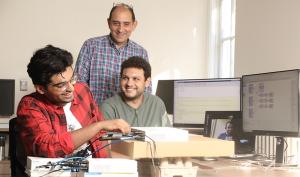
From smart homes and digital health to advanced manufacturing and precision agriculture, 5G+ and its associated applications will soon demand ubiquitous connectivity for billions of wireless devices. Anticipating additional strain on the wireless spectrum, the search is on for innovative frequency-sharing methods that enable seamless cohabitation of legacy and new users.
A team at the University of Virginia School of Engineering and Applied Science has made progress on this front: It has demonstrated a new signal-processing method that provides a high quality of service to users whose signals are very weak. Experimenting with software-defined radio transmissions of strong and weak signals simultaneously over the same frequency, the team discovered a way to allow a receiver to detect the weaker signal without any coordination between the two transmitters.
Nikos Sidiropoulos, Louis T. Rader Professor and chair of UVA’s Charles L. Brown Department of Electrical and Computer Engineering, leads the team. Sidiropoulos earned a three-year grant from the National Science Foundation’s Electrical, Communications and Cyber Systems division to enable efficient and seamless short-range communication free of disturbance from much stronger transmitters. The research extends his work on statistical signal processing, machine learning and matrix theory, as well as practical communications engineering.
“Picture yourself entering a parlor where two people are already involved in a loud conversation,” Sidiropoulos said. “As you quietly engage the person closest to you, you want that person to tune out the loud conversation to understand your whispers.”
A congested wireless spectrum is similar to the parlor: The strongest signals are the loudest. When a strong transmitter, such as a radio or TV station, occupies a certain spectrum band or frequency, the weaker, short-range users run into disturbance when trying to use that same frequency. To avoid such a disturbance, the weaker user has to coordinate its transmissions, listening in on the spectrum band it wants to use to make sure it’s clear before it sends its own signal.
Salah Ibrahim, who earned his doctorate in electrical engineering this year, teamed up with Paris Karakasis, a Ph.D. student advised by Sidiropoulos, and Ahmed Hussain, a third-year computer engineering and physics major, to test a new approach using software-defined radio. Karakasis learned how to operate software-defined radios during his undergraduate program at the Technical University of Crete.
The team applied repetition coding and machine learning tools in an entirely different way to create a technique to share frequency bands seamlessly. Here’s how it worked: The setup involved two transmit nodes, each with its own receiver. One transmitter mimicked a powerful radio station while a second transmitter served as the weaker user, such as a node in the internet of things. The team then ran a series of tests to evaluate performance of both the primary and secondary networks.
“Our experimental design assumes there is no cooperation or coordination between the two transmitters; as the weaker transmitter, I don’t know what the primary network is transmitting or the parameters chosen to modulate that signal,” Ibrahim said.
The weaker communicator repeats its transmission, sending two identical signals against the stronger communicator’s single transmission. The signal of interest repeats, but the interference noise does not. The team applied a machine learning tool to extract the unique common pattern from the weaker communicator’s duplicate signals.
“We showed that a receiver with two antennas can reliably detect a signal that is 40 decibels below when both are transmitting simultaneously over the same frequency,” Ibrahim said.
Ibrahim has joined a research and development lab in private industry, where he anticipates using the method to develop new products in wireless communication.
The team’s method offers network managers a new tool to achieve high data rates for a large number of users. Additionally, many internet of things applications require signals to be sent and received in a manner of milliseconds. Simultaneous transmission reduces signals’ hang time at a base station, a metric called low latency-communication.
“It is so rewarding to see elegant theory work so well in practice,” Sidiropoulos said.
The research in Sidiropoulos’ lab will continue, with new scenarios for experimentation that involve multiple secondary users.
“We want to explore whether we can maintain good performance for each node as the network grows,” Karakasis said. “The next step is to understand how more users affect the performance of the primary network.”
Ahmed Khalid will join the research team in January as one of Sidiropoulos’ new doctoral students. For the past nine years, Khalid has worked at a technology company that specializes in test and measurement. He is a principal systems engineer focused on aerospace and defense applications.